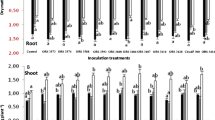Abstract
Nodulation and nitrogen fixation of black locust (Robinia pseudoacacia L.), a legume tree broadly used in Argentina for urban and agricultural afforestation, was studied in hydroponic culture. The development of seedlings inoculated with a local strain of Rhizobium, highly specific for R. pseudoacacia, was also compared with respect to non-inoculated but N-fertilised seedlings. This strain produced fast nodulation and high crop yield and leaf N content. Already nodulated plants with the local Rhizobium strain were assayed for growth in a greenhouse pot experiment with soil from a field where topsoil has been removed for industrial purposes, whilst pots with non-desurfaced soil from the same field were used as control. Non-inoculated plants were also grown in either control or desurfaced soil. Inoculated plants developed better than non-inoculated plants in desurfaced soil, and in control soil as well, suggesting that the symbiosis was able to overcome the nutrient limitation of the desurfaced soil. Non-inoculated plants were nodulated by native soil born Rhizobium, either in control or desurfaced soil, but they showed low final nitrogen leaf content and low nitrogen fixation activity, suggesting that native rhizobia were ineffective.



Similar content being viewed by others
Abbreviations
- DM:
-
Dry matter
References
Bradford M (1976) A rapid and sensitive method for the quantitation of microgram quantities of protein utilizing the principle of protein-dye binding. Anal Biochem 72:248–254
Dagar JC (1998) Nitrogen fixing fodder trees for degraded and problematic lands. In: Daniel JN, Roshetko JM (eds) Nitrogen fixing trees for fodder production. Winrock International, Morrilton, pp 73–81
Dawson JO (1986) Actinorhizal plants: their use in forestry and agriculture. Outlook Agric 15:202–208
Diem HG, Dommergues YR (1990) Current and potential uses and management of casuarinaceae in the tropics. In: Schwintzer CR, Tjepkema JD (eds) The biology of Frankia and actinorhizal plants. Academic, San Diego, pp 317–342
Feng Z, Dyckmans J, Flessa H (2004) Effects of elevated carbon concentration on growth and N2 fixation of young Robinia pseudoacacia. Tree Physiol 24:323–330
Forster JC (1995) Soil nitrogen. In: Alef K, Nannipieri P (eds) Methods in applied soil microbiology and biochemistry. Academic, London, pp 79–87
Franco AA, De Faria SM (1997) The contribution of N2-fixing legumes to land reclamation and sustainability in the tropics. Soil Biol Biochem 29:897–903
Gimenez JE, Salerno MI, Hurtado MA (2002) Rehabilitation of desurfaced soils by afforestation in La Plata County, Argentina. Land Degrad Dev 13:69–77
Gutteridge RC (1998) The potential of nitrogen fixing trees in livestock production systems. In: Daniel JN, Roshetko JM (eds) Nitrogen fixing trees for fodder production. Winrock International, Morrilton, pp 1–16
Hanover JW, Mebrahtu T (1996) Robinia pseudoacacia: temperate legume tree with worldwide potential. In: Powell MH (ed) Nitrogen fixing trees for acid soils—a field manual. Appendix A: nitrogen fixing tree highlights-species tolerant of acid soils. Winrock International, Morrilton, pp 90–91
Hoagland DR, Arnon DI (1950) The water-culture for growing plants without soil. Calif Agric Exp Stn Circ 347, Berkeley
Keresztesi B (1980) The black locust. Unasylva 32:23–33
Kuo S (1996) Phosphorus. In: Sparks RL (ed) Methods of soil analysis, Part 3: chemical methods. Soil Science Society of America book series number 5. American Society Of Agronomy, Madison, pp 894–895
Lal R (1996) Deforestation and land-use effects on soil degradation and rehabilitation in western Nigeria. II: soil chemical properties. Land Degrad Rehabil 7:87–98
Montagnini F (1992) Sistemas agroforestales- principios y aplicaciones en los trópicos. 2da. ed. OTS/CATIE, San José, Costa Rica
Norby RJ (1987) Nodulation and nitrogenase activity in nitrogen-fixing woody plants stimulated by CO2 enrichment of the atmosphere. Physiol Plant 71:77–82
Olesniewicz KS, Thomas RB (1999) Effects of mycorrhizal colonization on biomass production and nitrogen fixation of black locust (Robinia pseudoacacia) seedlings grown under elevated atmospheric carbon dioxide. New Phytol 142:133–140
Panagopoulos T, Hatzistathis A (1995) Early growth of Pinus nigra and Robinia pseudoacacia stands; contribution to soil genesis and landscape improvement on lignite spoils in Ptolemaida. Landsc Urban Plan 32:19–29
Pueppke SG, Broughton WJ (1990) Rhizobium sp. strain NGR234 and R. fredii USDA257 share exceptionally broad, nested host ranges. Mol Plant-Microb Interact 12:293–318
USDA (1972) Soil Survey Laboratory Methods and procedures for collecting soil samples. US Department of Agriculture Soil Survey Report 1. U.S. Gov. Print. Office, Washington, DC
Valverde C, Wall LG (2002) Nodule distribution on the roots of actinorhizal Discaria trinervis (Rhamnaceae) in pots. Environ Exp Bot 47:95–100
Vincent JM (1980) Factors controlling the legume-Rhizobium symbiosis. In: Newton WE, Horme-Johnson (eds) Nitrogen fixation vol II. University Park Press, Baltimore, pp 103–129
Walkley A, Black IA (1934) An examination of Degtjareff method for determining soil organic matter and a proposed modification of the chronic acid titration method. Soil Sci 37:29–38
Wheeler CT, Miller IM (1990) Current and potential uses of actinorhizal plants in Europe. In: Schwintzer CR, Tjepkema JD (eds) The biology of Frankia and actinorhizal plants. Academic, San Diego, pp 365–389
Zeleznik JD, Skousen JG (1996) Land reclamation: survival of three tree species on old reclaimed surface mines in Ohio. J Environ Qual 25:1429–1435
Author information
Authors and Affiliations
Corresponding author
Rights and permissions
About this article
Cite this article
Ferrari, A.E., Wall, L.G. Nodulation and growth of black locust (Robinia pseudoacacia) on a desurfaced soil inoculated with a local Rhizobium isolate. Biol Fertil Soils 43, 471–477 (2007). https://doi.org/10.1007/s00374-006-0125-2
Received:
Revised:
Accepted:
Published:
Issue Date:
DOI: https://doi.org/10.1007/s00374-006-0125-2




